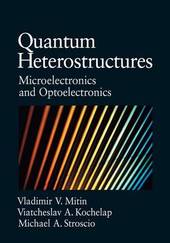
|
Quantum Heterostructures: Microelectronics and Optoelectronics
Paperback / softback
Main Details
| Title |
Quantum Heterostructures: Microelectronics and Optoelectronics
|
| Authors and Contributors |
By (author) Vladimir Mitin
|
|
By (author) Viacheslav Kochelap
|
|
By (author) Michael A. Stroscio
|
| Physical Properties |
| Format:Paperback / softback | | Pages:664 | | Dimensions(mm): Height 254,Width 178 |
|
| ISBN/Barcode |
9780521636353
|
| Classifications | Dewey:621.38152 |
|---|
| Audience | | Professional & Vocational | | Tertiary Education (US: College) | |
|---|
| Illustrations |
Worked examples or Exercises; 20 Tables, unspecified; 320 Line drawings, unspecified
|
|
Publishing Details |
| Publisher |
Cambridge University Press
|
| Imprint |
Cambridge University Press
|
| Publication Date |
13 July 1999 |
| Publication Country |
United Kingdom
|
Description
Quantum Heterostructures provides a detailed description of the key physical and engineering principles of quantum semiconductor heterostructures. Blending important concepts from physics, materials science, and electrical engineering, it also explains clearly the behaviour and operating features of modern microelectronic and optoelectronic devices. The authors begin by outlining the trends that have driven development in this field, most importantly the need for high-performance devices in computer, information, and communications technologies. They then describe the basics of quantum nanoelectronics, including various transport mechanisms. In the latter part of the book, they cover novel microelectronic devices, and optical devices based on quantum heterostructures. The book contains many homework problems and is suitable as a textbook for undergraduate and graduate courses in electrical engineering, physics, or materials science. It will also be of great interest to those involved in research or development in microelectronic or optoelectronic devices.
Reviews"[The authors] extensively describe the fundamental physical and engineering principles of semiconductor heterostructures. They combine concepts from physics, materials science, and device engineering in a unifying framework to establish an understanding of basic underlying concepts." Choice "The authors do a good job of explaining the various physical phenomena and in motivating their device applications...This book will be most useful to the physicist who has an interest in learning about nanoelectronics and quantum devices and who may contemplate joining the ranks of researchers in nanostructure physics and technology...a thorough introduction to the physical principles of nanostructures and their device applications. It should serve as a useful starting point for those individuals wanting to learn about the current thinking and the state of the art in nanoelectronics." Physics Today
|